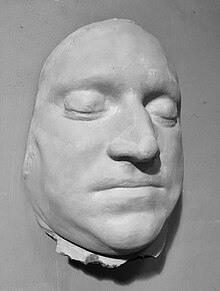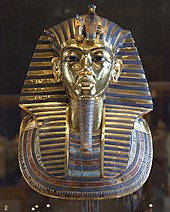
Back قناع الموت Arabic Пасмяротная маска Byelorussian Màscara mortuòria Catalan Posmrtná maska Czech Totenmaske German Mortmasko Esperanto Máscara mortuoria Spanish Surimask Estonian Hil mozorro Basque ماسک مرگ Persian



A death mask is a likeness (typically in wax or plaster cast) of a person's face after their death, usually made by taking a cast or impression from the corpse. Death masks may be mementos of the dead or be used for creation of portraits. The main purpose of the death mask from the Middle Ages until the 19th century was to serve as a model for sculptors in creating statues and busts of the deceased person. Not until the 1800s did such masks become valued for themselves.[1]
In other cultures a death mask may be a funeral mask, an image placed on the face of the deceased before burial rites, and normally buried with them. The best known of these are the masks used in ancient Egypt as part of the mummification process, such as the mask of Tutankhamun, and those from Mycenaean Greece such as the Mask of Agamemnon. When taken from a living subject, such a cast is called a life mask.
In some European countries, it was common for death masks to be used as part of the effigy of the deceased, displayed at state funerals; the coffin portrait was an alternative. Mourning portraits were also painted, showing the subject lying in repose. During the 18th and 19th centuries, masks were also used to permanently record the features of unknown corpses for purposes of identification. This function was later replaced by post-mortem photography.
- ^ Wallechinsky, Irving; Wallace, Irving (1978). The People's Almanac #2. New York: Bantam Books. pp. 1189–1192. ISBN 0553011375.